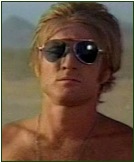Last time, I suggested that no matter how astonishing, everything you do, at some level, made sense, at the time you did it. Almost always, in situations like this, you were motivated by one or more of the formidable four.
I once worked for a clinically-diagnosable narcissist. This psychological malady renders a person unable to recognize anything that disagrees with the favorable fantasy they hold of themselves.
One needn’t be a narcissist, though, to succumb to the first formidable foe: looking good.
Every one of us prefers to look good—particularly in the eyes of the people we decide are important to us. Those whose childhood was particularly punitive when a disappointment occurred will relate more closely to the motivation to avoid looking bad.
As kids, many of us made innumerable blunders when taken over by one or the other of these motivators.
If you’re like me, you made a million mindless moves to appear as smooth and slick as your favorite Hollywood hero. In the decades since, our heroes may have changed, yet we’re still vulnerable to the desire to appear in as favorable a light as possible. Sometimes, even more favorable than possible.
Not long ago, I helped a pastor work through a difficult situation. He’d been caught preaching other ministers’ material, failing to fully credit his sources. As we unpacked Ralf’s failure he discovered he’d long felt inadequate as a rhetorician. He’d come to believe the swelling numbers in his congregation needed better sermons than he could bring. So, he “juiced” his messages by plagiarizing others.
For a brief season early in my business career, I enjoyed fairly stunning success. Near the pinnacle, I was flown by corporate jet to New York to receive some accolade for the performance of the business unit I ran. The return flight was so turbulent I expected to lose my lunch—literally—at any moment. Facing me, just inches from my knees was the Chairman of our parent company’s board. Rather than admit my intense distress, I tried to ride it out— barely avoiding a career-limiting disaster. Had my greatest fear been realized, the potential damage would’ve been far greater than the brief humiliation of admitting my weakness.
 Ministers are particularly vulnerable to looking good.
Ministers are particularly vulnerable to looking good.
It seems many congregations would prefer to follow an idealized image of a minister rather than an actual human being who, like every bible character, is flawed, needing the Savior. So, rather than model what it means follow Jesus amidst struggle and disappointment, ministers hide their scars, failings, and vulnerabilities from an adoring, albeit intolerant, church.
Detrich Bonhoeffer commented on this in Life Together: “The pious fellowship permits no one to be a sinner. So everyone must conceal his sin from himself and from the fellowship…So we remain alone with our sin, living in lies and hypocrisy.”
The tragic result, too often, is the eventual revelation of gross immorality, which mushroomed in the damp darkness created by the collusion of minister and congregation—both desiring to look good.
Coaching Distinctions # 6

Good stuff, Kirk. Like the Bonhoeffer quote a lot. By the way, was Robert Redford your favorite Hollywood hero as a kid?
Thanks, Nick, for your comments. Wellllllll, actually he was my girlfriend’s Hollywood hero (so, committed to “looking good”), he became mine. 🙁
We must find ways to turn the Church into a community where all can receive healing at the foot of the Cross…including our pastors. Hiding sin is NEVER the way to deal with it.